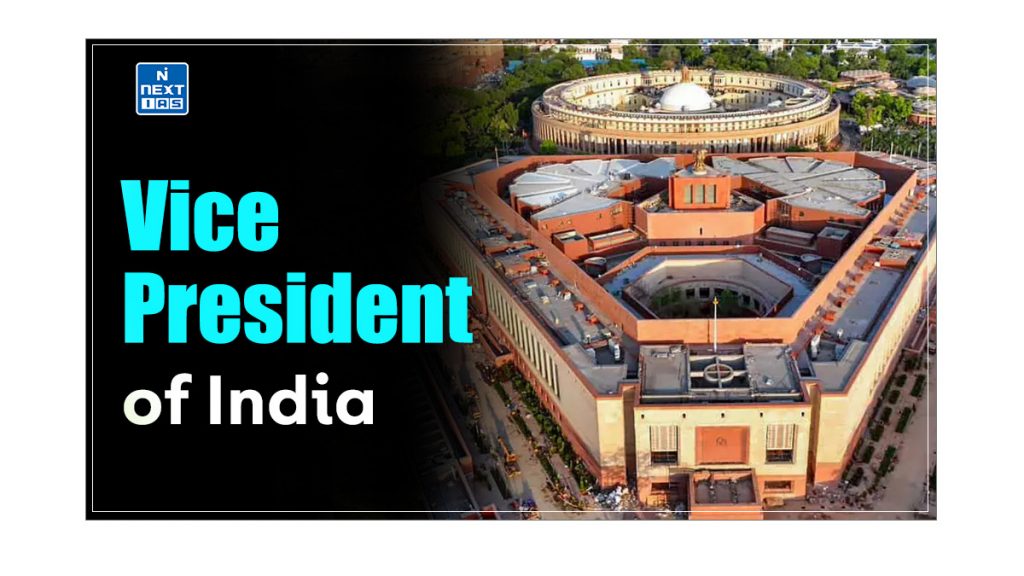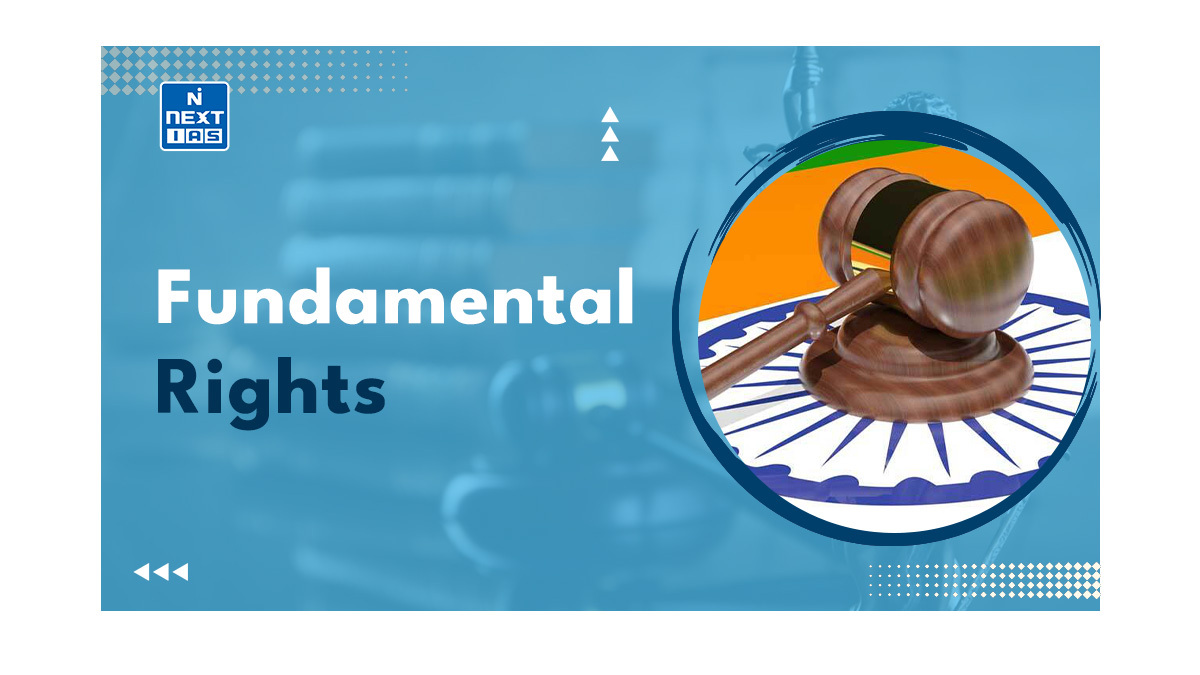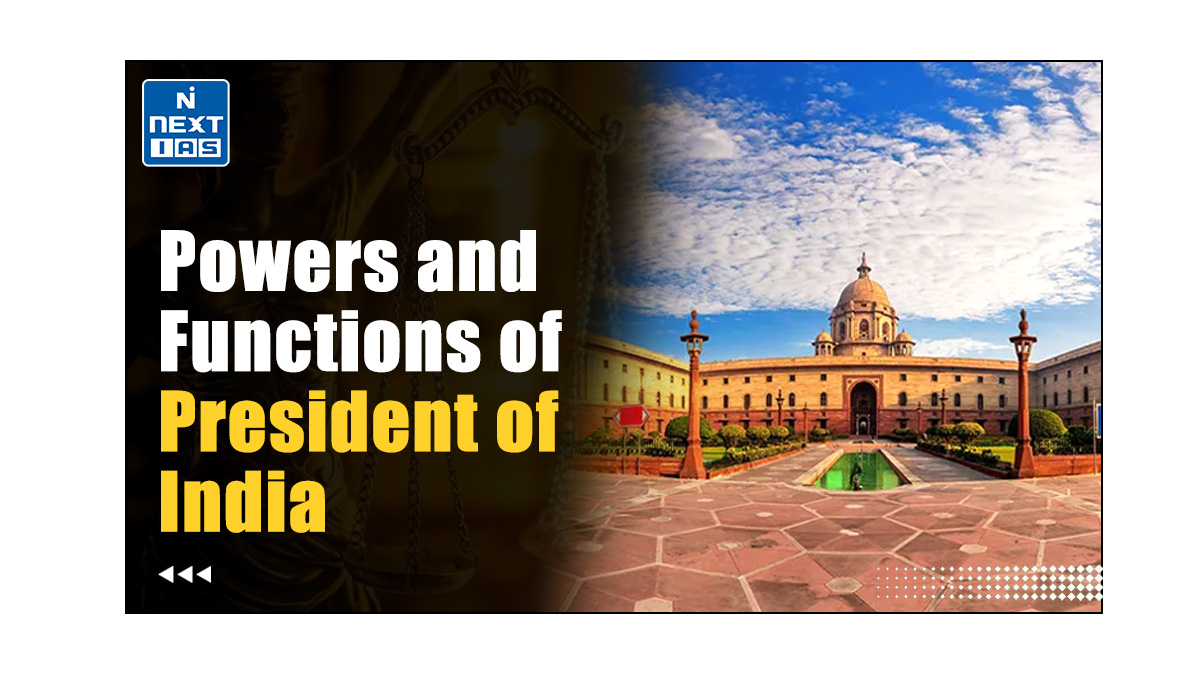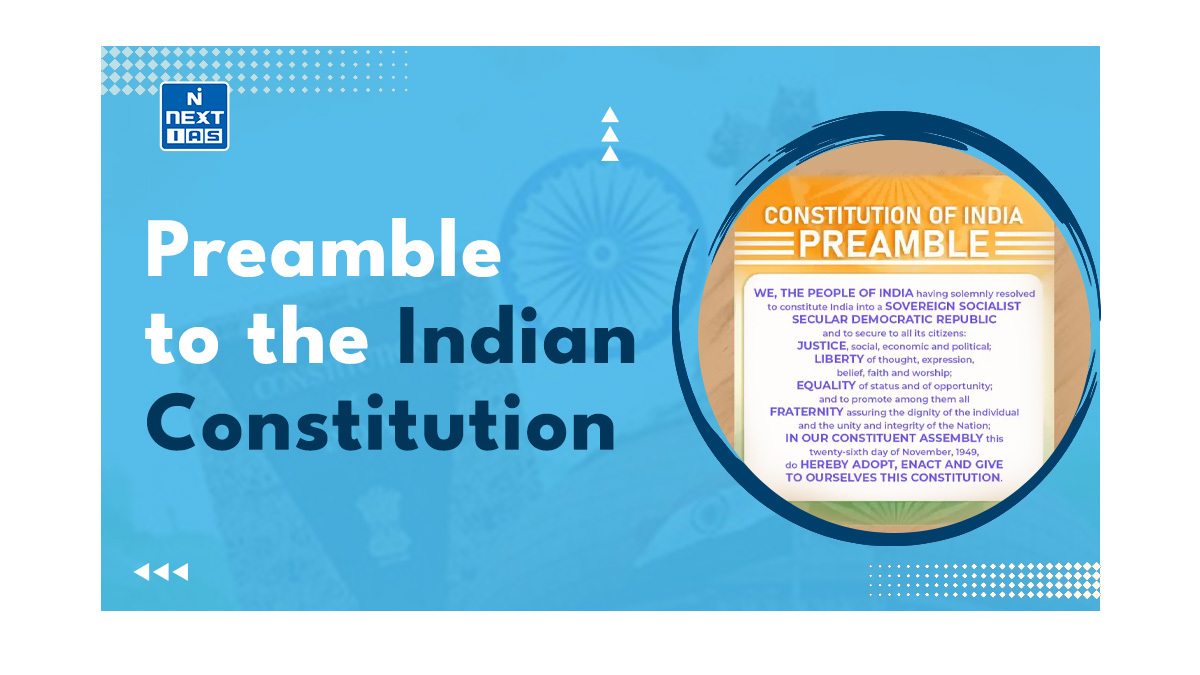
The office of the Vice President of India is the second-highest constitutional office in the country, ranking just below the President of India. Despite being assigned a limited role by the Constitution, the Vice President of India plays a crucial role in the functioning of the Government. This article of NEXT IAS aims to study in detail the Vice President of India, covering the related constitutional provisions, the process of elections and removal, conditions of office, functions, powers, and other related aspects.
About Vice President of India
- The Vice President of India is a constitutional office in India, serving as the second-highest dignitary in the country after the President.
- The office of the Vice President of India, as envisaged by the Constitution, combines legislative and executive responsibilities in such a way so as to ensure the smooth functioning of the Indian parliamentary system as well as the overall governance of the country.
| Note: The office of the Vice President of India is modelled on the lines of the American Vice-President. |
Constitutional Provisions Related to Vice President of India
- Articles 63-71 in Part V of the Indian Constitution contain key provisions related to the Vice President of India.
- The constitutional provisions mentioned under these articles deal with matters related to the election, term of office, oaths & affirmations, powers & functions, and other aspects related to the office of the Vice President of India.
Election of Vice President of India
- The Vice President of India is elected not directly by the people of India, but by the members of an electoral college as described below.
Electoral College of Vice President of India
| Members who vote in the Election of Vice President of India | Members who do not vote in the Election of Vice President of India |
| The members (both elected as well as nominated) of both the Houses of Parliament. | The members of the Legislative Assemblies of States. |
- The Electoral College of the Vice President of India is different from the Electoral College of the President of India in the following two respects:
| Electoral College of Vice President of India | Electoral College of President of India |
|---|---|
| The Electoral College of Vice-President consists of both Elected and Nominated Members of both the Houses of Parliament. | The Electoral College of the President consists of only Elected Members of both the Houses of Parliament. |
| It does not include the Members of the State Legislative Assemblies. | It includes the Elected Members of the State Legislative Assemblies and Elected Members of Legislative Assemblies of the Union Territories of Delhi and Puducherry. |
- The election of the Vice-President is held in accordance with the System of Proportional Representation by means of the Single Transferable Vote and the voting is by Secret Ballot.
- This manner of election of the Vice President of India is the same as that of the President of India.
- All doubts and disputes in connection with the election of the Vice-President are inquired into and decided by the Supreme Court whose decision is final.
- The election of a person as Vice-President cannot be challenged on the ground that the Electoral College was incomplete (i.e. the existence of any vacancy among the Members of the Electoral College).
- If the election of a person as Vice-President is declared void by the Supreme Court, acts done by him/her before the date of such declaration of the Supreme Court are not invalidated and continue to remain in force.
Qualification of Vice President of India
A person to be eligible for election as the Vice President of India should possess the following qualifications.
- He/she should be a citizen of India.
- He/she should have completed 35 years of age.
- He/she should be qualified for election as a member of the Rajya Sabha.
- He/she should not hold any office of profit under the Union Government or any State Government or any Local Authority or any other Public Authority.
| Note: A sitting President or Vice-President of the Union, the Governor of any State, and a Minister for the Union or any State is not deemed to hold any office of profit and are qualified for being a candidate for Vice-President. |
Further, a vice-presidential candidate has to fulfill the following conditions for his/her election as the Vice President of India:
- His/her nomination for election to the office of President must be subscribed by at least 20 electors as proposers and 20 electors as seconders.
- He/she has to make a security deposit of ₹15,000 in the Reserve Bank of India.
Oath or Affirmations by Vice President of India
- The Oath of Office to the Vice President is administered by the President or some person appointed on that behalf by him/her.
- In his/her oath, the Vice-President swears:
- To bear true faith and allegiance to the Constitution of India,
- To faithfully discharge the duties of his/her office.
Conditions of Office of Vice President of India
The conditions of the office of the Vice President of India as laid down by the Indian Constitution are as follows:
- He/she should not be a Member of either House of Parliament or a House of the State Legislature.
- If any such person is elected as the Vice President, he/she is deemed to have vacated the seat in that House on the date on which he/she enters the office as Vice-President.
- He/she should not hold any other Office of Profit.
Term of Vice President of India
- The Vice-President of India holds office for a term of five years from the date on which he/she enters his/her office.
- He can hold office beyond his term of 5 years until his/her successor assumes charge of that office.
- He is eligible for re-election to that office for any number of terms.
Resignation of Vice President of India
The Vice-President of India can resign from his/her office at any time by addressing the resignation letter to the President of India.
Removal of Vice President of India
- The Vice President of India can be removed from his/her office even before the completion of his/her term.
- It is to be noted that unlike in the case of the President of India, the removal of the Vice President of India does not require a formal impeachment.
Grounds of Removal of Vice President of India
- No ground has been mentioned in the Constitution for the removal of the Vice President of India.
Process of Removal of Vice President of India
- A resolution for the removal of the Vice President of India can be introduced only in the Rajya Sabha, and not in the Lok Sabha.
- Moreover, no such resolution for the removal can be moved unless at least 14 days’ advance notice has been given.
- This resolution for removal should be passed in the Rajya Sabha by an Effective Majority (i.e. a majority of the then members of Rajya Sabha) and agreed to by Lok Sabha by a Simple Majority.
Vacancy in Office of Vice President of India
- A vacancy in the office of the Vice President can occur in the following ways:
- On the expiry of his/her tenure of five years,
- By his/her resignation,
- On his/her removal,
- By his/her death,
- Other cases, such as when he/she becomes disqualified to hold office or when his/her election is declared void.
- If the vacancy is going to be caused by the expiration of the term of the sitting Vice President, an election to fill the vacancy must be held before the expiration of the term.
- If the office of Vice President falls vacant by resignation, removal, death, or otherwise, then an election to fill the vacancy should be held as soon as possible after the occurrence of the vacancy.
- The newly elected Vice-President remains in office for a full term of five years from the date he/she assumes charge of his/her office.
Powers and Functions of Vice President of India
The power and functions of the Vice-President of India are two-fold as explained in the sections below.
Ex-Officio Chairman of Rajya Sabha
The Vice President of India acts as the Ex-Officio Chairman of the Rajya Sabha. In this capacity, his/her powers and functions are similar to those of the Speaker of Lok Sabha.
| Note: W.r.t. his/her function to act as the Chairman of Rajya Sabha, the Vice President of India resembles the American Vice President, who also acts as the Chairman of the Senate – the Upper House of the American Legislature. |
Acting or Serving as President of India
- The Vice President of India acts as President of India when a vacancy occurs in the office of the President due to his/her resignation, impeachment, death, or otherwise.
- The Vice President can act as President only for a maximum period of six months within which a new President has to be elected.
- When the sitting President is unable to discharge his/her functions due to absence, illness, or any other cause, the Vice-President discharges his/her functions until the President resumes his/her office.
| Note: While acting as President or discharging the functions of President, the Vice-President does not perform the duties of the office of the Chairman of Rajya Sabha. During this period, those duties are performed by the Deputy Chairman of the Rajya Sabha. |
Salaries and Allowances of Vice President of India
- The Constitution has not fixed any emoluments for the Vice-President in that capacity.
- He/she draws his/ her regular salary in his/her capacity as the ex-officio Chairman of the Rajya Sabha.
- The Vice President is also entitled to daily allowance, free furnished residence, medical, travel, and other facilities.
| Note: During any period when the Vice-President acts as President or discharges the functions of the President, he/she is not entitled to the salary or allowances payable to the Chairman of Rajya Sabha, but the salary and allowance of the President of India. |
Comparison of Indian and American Vice President
Though the office of the Indian Vice-President is modelled on the lines of the American Vice-President, there is one difference between the two as explained below.
| Indian Vice President | American Vice President |
|---|---|
| Indian Vice-President does not assume the office of President when it falls vacant for the unexpired term. He merely serves as an acting President until the new President assumes charge. | The American Vice-President succeeds to the President’s office when it falls vacant, and remains President for the unexpired term of his predecessor. |
Conclusion
The Vice President of India, as the second highest constitutional authority of the nation, occupies a pivotal position in the democratic framework of the country. Despite being assigned limited functions, the Vice President of India plays a significant role in maintaining the political continuity of the Indian state.
Frequently Asked Questions (FAQs)
What is the position of the Vice-President of India in the official warrant of precedence?
The Vice President of India is accorded a rank next to the President of India in the official warrant of precedence.
How is the Vice President of India elected?
The Vice President is elected by an Electoral College consisting of members of both Houses of the Indian Parliament (Lok Sabha and Rajya Sabha), but excluding the members of the State Legislative Assemblies. The election is held through a secret ballot, and the candidate who secures the majority of the votes cast is declared the winner.
Who was the first Vice President of India?
The first Vice-President of India was Sarvepalli Radhakrishnan.
Who is the Vice President of India?
Presently, Shri Jagdeep Dhankar is the Vice President of India.






